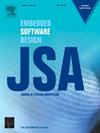Balancing I/O and wear-out distribution inside SSDs with optimized cache management
IF 3.7
2区 计算机科学
Q1 COMPUTER SCIENCE, HARDWARE & ARCHITECTURE
引用次数: 0
Abstract
NAND flash memory-based solid-state drives (SSDs) have been adopted as storage infrastructure in a wide range of computing systems. In order to service an I/O request, the logical page address (LPA) of the request should be mapped to a physical page address (PPA), termed page-level address mapping in SSDs. As a fundamental mapping scheme, static mapping needs a small-scale mapping table and ensures good read parallelism, but it may bring about uneven I/O and wear-out distribution across SSD parallel units (e.g. flash planes), thus resulting in low write efficiency. To mitigate the negative effects of static mapping, this paper proposes a novel cache management scheme to not only guarantee I/O responsiveness but also balance I/O and wear-out distribution. Specifically, we first introduce directly flushing a portion of data pages onto the flash array while they are cold and the target parallel units have endured a small number of erase operations. After that, we present a method for selecting victim data pages from the data cache, by referring to the factors of pending I/O requests and the wear-out level on the flash memory. Through a series of simulation experiments on selected block I/O traces of real-world applications, we show that our approach achieves an average I/O latency reduction of 16.1% compared to Baseline, 13.6% over GCaR, 12.4% over LCR, and 6.6% over ARB while simultaneously balancing I/O and wear-out distribution. These results demonstrate its superiority over existing state-of-the-art schemes.
通过优化缓存管理平衡ssd内的I/O和损耗分布
基于NAND闪存的固态硬盘(ssd)已被广泛应用于各种计算系统中作为存储基础设施。为了服务I/O请求,请求的逻辑页地址(LPA)应该映射到物理页地址(PPA),在ssd中称为页级地址映射。静态映射是一种基本的映射方案,它需要一个小规模的映射表,并保证良好的读并行性,但它可能导致SSD并行单元(如闪存平面)之间I/O分布不均匀和磨损,从而导致写效率低。为了减轻静态映射的负面影响,本文提出了一种新的缓存管理方案,既能保证I/O响应,又能平衡I/O和损耗分布。具体来说,我们首先引入了当一部分数据页处于冷状态且目标并行单元经历了少量擦除操作时直接将它们刷新到闪存阵列上。之后,我们提出了一种从数据缓存中选择受害数据页的方法,该方法参考了挂起I/O请求的因素和闪存上的磨损程度。通过对实际应用中选定的块I/O轨迹进行的一系列模拟实验,我们表明,与Baseline相比,我们的方法平均I/O延迟减少了16.1%,比GCaR减少了13.6%,比LCR减少了12.4%,比ARB减少了6.6%,同时平衡了I/O和损耗分布。这些结果表明,它优于现有的最先进的方案。
本文章由计算机程序翻译,如有差异,请以英文原文为准。
求助全文
约1分钟内获得全文
求助全文
来源期刊

Journal of Systems Architecture
工程技术-计算机:硬件
CiteScore
8.70
自引率
15.60%
发文量
226
审稿时长
46 days
期刊介绍:
The Journal of Systems Architecture: Embedded Software Design (JSA) is a journal covering all design and architectural aspects related to embedded systems and software. It ranges from the microarchitecture level via the system software level up to the application-specific architecture level. Aspects such as real-time systems, operating systems, FPGA programming, programming languages, communications (limited to analysis and the software stack), mobile systems, parallel and distributed architectures as well as additional subjects in the computer and system architecture area will fall within the scope of this journal. Technology will not be a main focus, but its use and relevance to particular designs will be. Case studies are welcome but must contribute more than just a design for a particular piece of software.
Design automation of such systems including methodologies, techniques and tools for their design as well as novel designs of software components fall within the scope of this journal. Novel applications that use embedded systems are also central in this journal. While hardware is not a part of this journal hardware/software co-design methods that consider interplay between software and hardware components with and emphasis on software are also relevant here.
 求助内容:
求助内容: 应助结果提醒方式:
应助结果提醒方式:


